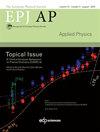Mechanism of broadened phase transition temperature range in LaFeCoSiC compounds prepared upon high-pressure annealing
IF 0.9
4区 物理与天体物理
Q4 PHYSICS, APPLIED
引用次数: 3
Abstract
The cobalt-carbon co-doped NaZn13 -type compound LaFe10.95 Co0.65 Si1.4 C0.15 (LFCSC) is one of the most promising candidates for room-temperature working substance in magnetic refrigerator due to its many excellent properties such as large reversible entropy, low cost, and short annealing time. However, owing to the narrow temperature regions of magnetic phase transition in LFCSC, the operation-temperature window for magnetic refrigeration is limited, which restricts its actual application to some extends. In this paper, it is shown that the application of high-pressure to LFCSC during annealing can tailor atomic environment and magnetic transition, which leads to a strongly expanded phase transition temperature range in LFCSC. This broadening behavior can be well understood by importing the magnetoelastic interaction of localized magnetic moments into a microscopic model. The refrigeration performance of the high-pressure annealed sample with wide phase transition temperature range is enhanced according to the relative cooling power (RCP). On the contrary, temperature averaged entropy change (TEC) exhibits a weakened value in the high-pressure annealed sample, which suggests that the magnetic cooling performance could not be effectively improved by simply expanding the phase transition temperature range in the second-order phase transition materials. However, high-pressure annealing would be helpful to the magnetic refrigeration performance for the first-order phase transition materials.高压退火制备的LaFeCoSiC化合物相变温度范围变宽的机理
钴碳共掺杂的NaZn13型化合物LaFe10.95 Co0.65 Si1.4 C0.15 (LFCSC)具有可逆熵大、成本低、退火时间短等优点,是磁性冰箱室温工作材料中最有前途的候选材料之一。然而,由于LFCSC的磁相变温度区域较窄,限制了磁制冷的工作温度窗口,在一定程度上制约了其实际应用。研究表明,在LFCSC退火过程中施加高压可以调整原子环境和磁转变,从而使LFCSC的相变温度范围大大扩大。通过将局域磁矩的磁弹性相互作用引入微观模型,可以很好地理解这种展宽行为。宽相变温度范围的高压退火试样的制冷性能随相对冷却功率(RCP)的增大而增大。温度平均熵变(TEC)在高压退火样品中呈减弱趋势,说明单纯扩大二级相变材料的相变温度范围不能有效提高磁冷却性能。高压退火有利于提高一阶相变材料的磁致冷性能。
本文章由计算机程序翻译,如有差异,请以英文原文为准。
求助全文
约1分钟内获得全文
求助全文
来源期刊
CiteScore
1.90
自引率
10.00%
发文量
84
审稿时长
1.9 months
期刊介绍:
EPJ AP an international journal devoted to the promotion of the recent progresses in all fields of applied physics.
The articles published in EPJ AP span the whole spectrum of applied physics research.

 求助内容:
求助内容: 应助结果提醒方式:
应助结果提醒方式:


